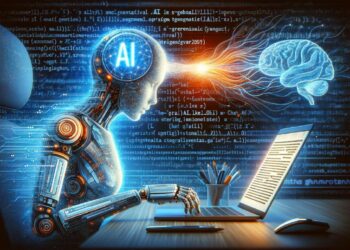The craft of software engineering, once synonymous with typing lines of code, is undergoing a revolutionary transformation. Artificial Intelligence, specifically through advanced AI coding assistants and large language models (LLMs), is shifting the core focus of developers from writing code to directing and orchestrating it. This is not merely an incremental upgrade to existing tools; it represents a fundamental change in development velocity, quality, and accessibility. AI is becoming the new standard for coding, augmenting human capabilities, automating tedious tasks, and enabling smaller teams to tackle projects of unprecedented complexity. For developers, embracing this shift is not optional—it is essential for professional relevance and peak productivity in the modern digital economy.
This extensive guide will explore the mechanics of AI-assisted coding, analyze its profound impact on the software development lifecycle, detail the essential tools, and chart the course for developers navigating this intelligent new frontier.
Understanding the AI Coding Revolution
AI coding assistants are sophisticated tools, often powered by vast pre-trained LLMs, that are fine-tuned on billions of lines of public code. They operate through various forms of assistance, moving from simple suggestions to generating complex, multi-file projects.
A. Code Generation and Completion
The most visible function of these tools is their ability to anticipate and complete code as you type, or generate entire functions from natural language prompts.
- Contextual Suggestion: Unlike traditional IDE auto-complete, AI assistants understand the context and intent of the surrounding code and the file structure. They suggest not just keywords, but entire, syntactically correct blocks of logic (e.g., generating a full
forloop to iterate over a specific data structure). - Natural Language to Code: A developer can describe a desired feature in plain English (e.g., “create a function to fetch user data from the
/api/usersendpoint and handle a 404 error”), and the AI will translate that intent directly into executable code in the desired language. - Repetitive Task Automation: AI excels at generating boilerplate code, setting up testing frameworks, scaffolding components, and writing documentation headers, saving hours of tedious, repetitive work.
B. Debugging and Error Correction
The time spent debugging is a significant portion of the development cycle. AI dramatically shortens this process by identifying flaws and suggesting fixes.
- Proactive Error Highlighting: As code is written, the AI analyzes it for potential runtime errors, security vulnerabilities, or logical bugs, often suggesting corrective action before the code is even compiled.
- Explanations of Complex Code: A developer can highlight an unfamiliar legacy block of code and ask the AI to explain its purpose, inputs, outputs, and side effects in simple, clear language, accelerating onboarding and maintenance.
- Refactoring Suggestions: The AI can analyze existing codebases and recommend modern refactoring patterns, improving performance, readability, and adherence to language best practices.
C. Language Translation and Migration
AI acts as a universal translator for programming languages, vastly simplifying maintenance and migration efforts.
- Code Transpilation: The ability to convert a block of code from one language (e.g., Python) to another (e.g., JavaScript) with remarkable accuracy, accelerating the migration of legacy systems.
- API Adaptation: When working with new or updated APIs, the AI can rapidly generate the correct syntax and boilerplate code for integration, eliminating the need to comb through extensive documentation manually.
Essential AI Coding Tools Shaping the Industry
The market for AI coding assistants is highly competitive, with several tools establishing themselves as indispensable parts of the modern developer toolkit.
1. GitHub Copilot (The Pioneer)
- Integration: Deeply integrated into popular IDEs (VS Code, Visual Studio, JetBrains suite).
- Core Function: Provides real-time, context-aware code suggestions based on the file content and adjacent code.
- Training Data: Trained on a massive corpus of public GitHub repositories, giving it wide proficiency across numerous languages and frameworks.
2. Amazon CodeWhisperer (Security-Focused)
- Integration: Designed to work within AWS development environments and enterprise IDEs.
- Core Function: Offers code suggestions with a strong emphasis on security best practices. It scans generated code for hardcoded credentials or common vulnerabilities and flags them instantly.
- Unique Feature: Provides a feature that allows developers to filter code suggestions based on open-source licenses, helping to avoid legal or licensing complications.
3. AI Integration in IDEs (The Native Approach)
- JetBrains AI Assistant: Integrated directly into the JetBrains suite (IntelliJ, PyCharm, etc.), providing native chat features for debugging and test generation.
- VS Code Extensions: Numerous third-party and native extensions (often powered by OpenAI or similar models) that offer enhanced completion and code analysis within the dominant code editor.
4. Self-Hosted and Fine-Tuned Models
- Data Privacy: Enterprises handling highly sensitive, proprietary code are utilizing smaller, self-hosted, or privately fine-tuned open-source LLMs (often variations of models like Llama or Code Llama) within their own secure networks.
- Codebase-Specific Knowledge: These models are trained specifically on the company’s private, internal codebase, making them exceptionally effective at generating code that adheres to internal standards and utilizes proprietary APIs.
 The Strategic Shift in the Development Lifecycle (SDLC)
The Strategic Shift in the Development Lifecycle (SDLC)
AI coding fundamentally alters the dynamics and efficiency of every phase of the Software Development Lifecycle.
A. Requirements and Planning
- Automated Documentation: AI can analyze preliminary design documents or user stories and automatically draft technical specifications, API documentation outlines, and function signatures.
- Feasibility Analysis: Running simulations or generating mock prototypes to quickly assess the technical feasibility and complexity of a new feature idea.
B. Coding and Implementation (The 10x Effect)
- Velocity Increase: Studies show developers using AI tools experience significant increases in development speed, often exceeding 50% for standard tasks, enabling “10x productivity” in specific areas.
- Focus on Orchestration: Developers spend less time on syntax and implementation details and more time on high-level architecture, designing data flows, and integrating complex components.
C. Testing and Quality Assurance (QA)
- Test Case Generation: AI can read production code and instantly generate comprehensive unit tests, integration tests, and even security test cases, ensuring high test coverage with minimal manual effort.
- Automated Peer Review: AI can act as a tireless peer reviewer, automatically checking pull requests for style guide violations, potential performance bottlenecks, and security flaws before human review begins.
D. Deployment and Maintenance
- Infrastructure-as-Code (IaC): Generating necessary deployment scripts, Kubernetes manifests, or Terraform files from simple service descriptions.
- Root Cause Analysis (RCA): When a production error occurs, the AI can quickly ingest logs, trace stack dumps, and compare code changes to identify the probable root cause, drastically shortening Mean Time To Resolution (MTTR).
Navigating the Challenges and Ethical Considerations
The rapid adoption of AI coding assistants is not without its pitfalls, demanding careful management of security, quality, and ownership.
A. Security and Vulnerability Management
- Inherent Flaws: AI models, while capable, can sometimes generate code that is syntactically correct but contains subtle, exploitable security vulnerabilities (e.g., poor input validation, weak cryptographic practices).
- The “Garbage In, Garbage Out” Problem: If the training data contains insecure or outdated code, the AI is likely to replicate those flaws in its suggestions. Human oversight is non-negotiable for security-critical functions.
B. Intellectual Property (IP) and Licensing
- Training Data Contamination: Since AI models are trained on public code, there is a risk that the generated code might unintentionally reproduce snippets that fall under specific open-source licenses (like GPL or MIT).
- Proprietary Risk: Organizations must have clear policies on which AI tools their developers can use, particularly avoiding those that might use the company’s proprietary code as input to further train the public model.
C. Code Quality and “Acceptance Bias”
- The Lazy Developer: There is a risk that developers, especially junior ones, will accept AI-generated code without sufficient critical review or deep understanding, leading to complex, poorly optimized, or inefficient solutions entering the codebase.
- Knowledge Degradation: Over-reliance on AI for basic syntax and implementation tasks could lead to a degradation of fundamental coding knowledge and troubleshooting skills among the new generation of developers.
 The Future of the Developer: Prompt Engineer and Architect
The Future of the Developer: Prompt Engineer and Architect
The rise of AI coding assistants demands a radical shift in the definition of a “good developer.” The future talent market will value skills that directly leverage and manage AI, not just traditional coding ability.
1. The Rise of the Prompt Engineer
Success with AI tools depends on the quality of the input. Developers must master the art of prompt engineering.
- Contextual Clarity: The ability to provide highly specific, clear, and context-rich prompts that guide the AI to the exact desired outcome, minimizing unnecessary iterations.
- Constraint Setting: Defining precise constraints, desired libraries, coding styles, and security requirements within the prompt to ensure the output is immediately usable.
2. Focus on High-Level Architecture and Integration
The value of a human developer moves up the stack.
- System Design: Spending less time on function writing and more time on designing scalable, resilient, and complex architectural blueprints (e.g., microservices, cloud infrastructure, data pipelines).
- Human-Centric Design: Focusing on non-automatable skills like understanding ambiguous user requirements, applying emotional intelligence to team collaboration, and ensuring the final product provides genuine, human-centric value.
3. The AI Management Skillset
Future senior developers will be less about coding proficiency and more about managing AI output.
- Verification and Validation: Developing expert skills in rapidly auditing, verifying, and testing AI-generated code for security, performance, and compliance.
- Toolchain Integration: Integrating and managing various AI tools seamlessly into the continuous integration/continuous deployment (CI/CD) pipeline.
The transition to AI-assisted coding is already underway. It is creating a world where software is built faster, with fewer human-induced errors, and by teams empowered to concentrate their brilliance on truly complex, strategic challenges. Developers who embrace the role of the AI conductor—expertly directing and refining the output of their intelligent assistants—will define the cutting edge of the software industry for the next generation.










